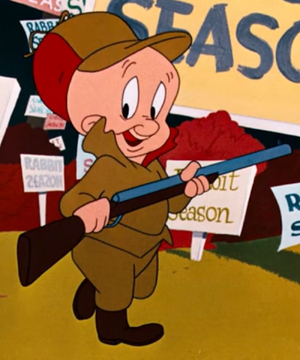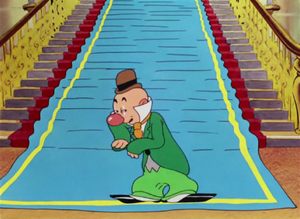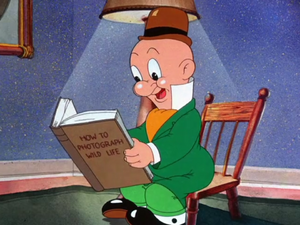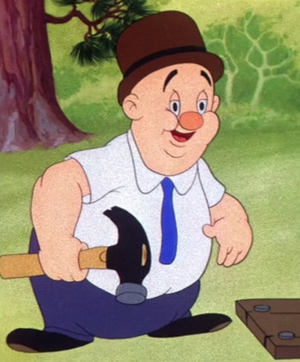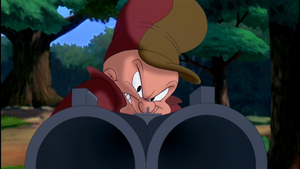Elmer Fudd
Elmer J. Fudd is a major character and antagonist in the Looney Tunes and Merrie Melodies theatrical shorts. He often appears as the archenemy of Bugs Bunny, who he aims to hunt in many occasions. However, he would end up being foiled by both Bugs' wise tricks and his own gullibility. He is one of the few human characters that appear in the main cast, alongside Yosemite Sam and Granny. His voice was originated by Mel Blanc, but is best known by his replacement Arthur Q. Bryan, who provided his distinct vocalization.
Elmer's protégé in Tiny Toon Adventures is Elmyra Duff.
Character description
Elmer is one of Bugs Bunny's most enduring antagonists, often portrayed as a bumbling and bald hunter armed with a double-barrel shotgun. Despite his occupation, he is seen as anything but menacing. He is incredibly slow-witted, timid, and largely ineffective, often unable to defeat Bugs in their battle of wits. His misguided efforts earn him the title of a foolish "nimrod." His schemes are constantly foiled by his own blunders, much to Bugs' delight. Elmer's catchphrase is, "Shhh. Be vewy vewy quiet, I'm hunting wabbits," as well as his trademark laughter.
His inability to outsmart or capture Bugs is also a core part of their rivalry, with Bugs seeing the former as less of a genuine threat. While Elmer proves himself to be determined in his goals, Bugs uses his foolishness as an advantage to his trickery. As director Chuck Jones had described him, Elmer is shown to be the type of person who is "afraid of someone going to interfere him."[4]
Elmer-speak
Elmer speaks with a unique speech impediment, in which he nearly vocalizes Rs and Ls, pronouncing them as W instead. This trait is prevalent since his official debut in Elmer's Candid Camera, where the writers of the cartoons would give him lines filled with these letters to further exaggerate his nebbish qualities. An example of would be in the 1942 short The Wacky Wabbit, in which he says the line, "Thewe's something awfuwwy scwewy going on awound here." Some of the others lines given to Elmer include doing Shakespeare's Romeo as "What wight thwough yonduh window bweaks!" (in the 1944 short, Stage Door Cartoon), or Wagner's Ride of the Valkyries as "Kiww the wabbit, kiww the wabbit, kiww the wabbit!" (in 1957's What's Opera, Doc?). Animation historian Leonard Maltin describes Elmer's speech patterns as "Elmer Fudd-ese".[4]
Ironically, part of the joke is that he is incapable of pronouncing words correctly, but address own first name right. Elmer would properly pronounce an "r" or "l" sound on occasion, depending on whether or not it was vital for the audience to understand what the word was. In The Old Grey Hare, for instance, he clearly pronounces the "r" in the word "picture".
Appearances
TV series
Movies
Shorts
Comics
Video games
Biography
Wabbit Season
We're All a Little Looney
Come On and Slam! and Welcome to the Jam!
Elmer Gets Modern
Going Down the Rabbit Hole
Elmer Gets Retro
Elmer Sells Out
Development
Prototype and confusion with Egghead
Elmer's origins are highly disputed and has led to a lot of confusion with another character, Egghead, who first appeared in the 1937 Tex Avery short, Egghead Rides Again. Many animation historians believe that Egghead evolved into Elmer over a couple of years. However, Michael Barrier asserts that "Elmer Fudd was not a modified version of his fellow Warner Bros. character Egghead", adding that the two were already distinct characters as evident by a publicity sheet for Cinderella Meets Fella, which mentioned that the former was "Egghead's brother."[5]
Elmer's first actual appearance was in Avery's Little Red Walking Hood, which was released November 6, 1937. Though already in his prototype phase, the early version of Elmer shares a similar likeness to his modern design–including his bald head and bulbous nose–but contains a different personality and vocal characterization. This version of Elmer also appeared in a number of Avery shorts before 1940, including 1938's A Feud There Was (which is the first to use his name on-screen). Elmer's name was also used in the lobby cards for The Isle of Pingo Pongo and Cinderella Meets Fella. He was last seen in this form in the 1939 short Believe It or Else.
Finalized Elmer
Elmer officially debuted in the 1940 Chuck Jones short Elmer's Candid Camera, which actually marked as his ninth appearance since Little Red Walking Hood. The character's appearance was refined, giving him a chin and less bulbous nose, though he still wore his old clothing that was seen in the earlier Tex Avery shorts. Arthur Q. Bryan, who previously voiced Dan McFoo in the cartoon Dangerous Dan McFoo, used that character's vocalization in portraying Elmer for this short. In Candid Camera, Elmer was paired with a grey rabbit who keeps on pestering him until he goes mad; this rabbit was a prototype for what would later become Bugs Bunny. Later in that year, Elmer appeared in Friz Freleng's Confederate Honey and The Hardship of Miles Standish, both of which use his Candid Camera characterization as a basis, but were carryovers from Ben Hardaway and Cal Dalton's work that would have planned to use Egghead.
Elmer's first appearance as a hunter was in the 1940 short A Wild Hare, directed by Tex Avery, and starring Bugs Bunny in his official debut. Elmer's design in this short was created by Bob Givens, who gave him a slimmer appearance (which later got reused in Jones' Good Night Elmer, but without the red nose) and his familiar hunting clothes. From that short onward, Elmer's role became that of a would-be hunter and hapless antagonist in various Bugs Bunny shorts, cementing itself for starting one of animation's most celebrated rivalries. In the interim, both Elmer and Bugs appeared in the 1941 Chuck Jones Elmer's Pet Rabbit, which was the first to identify the latter character by his name.
Fat Elmer
For a short time in the 1941-1942 season, Elmer was shown in a modified appearance for four cartoons: Wabbit Twouble, The Wacky Wabbit, The Wabbit Who Came to Supper, and Fresh Hare. In these shorts, Elmer became heavy-set and beer-bellied, patterned after his actor Arthur Q. Bryan. According to Clampett, Elmer's design was changed because "we artists were never satisfied with the way he looked—he didn't look funny."[6] The "fat" Elmer design was also used in the wartime short Any Bonds Today?, in which Bugs promoted war bonds against a patriotic background. Following these entries, Elmer was reverted back to a more traditional design in The Hare-Brained Hypnotist.
Gallery
- Main article: Elmer Fudd/Gallery
Toys and merchandise
Behind the scenes
- In Rabbit Fire, Elmer states that he is a vegetarian and only hunts for the sport of it. However, this is contradicted with his appearance in Easter Yeggs, where he attempts to make a stew out of the Easter Rabbit, and the later short What's My Lion?, where he makes steaks for himself (which were promptly stolen by a mountain lion). Furthermore, Elmer's claim of his vegetarianism in Rabbit Fire is likely a one-off gag for the cartoon, as it is not a consistent character trait throughout his appearances.
- Elmer's non-theatrical demeanor was a subject of criticism among the creative staff of Warner Bros. Cartoons, notably Friz Freleng, who created Yosemite Sam as a more fearsome antagonist to Bugs Bunny. Similarly, Chuck Jones created Marvin the Martian as a response to Elmer's softer personality, although Marvin was a more composed character when compared to Sam.
In popular culture
- In the 1972 film What's Up, Doc?, during the final scene where Howard and Judy kiss each other in an airplane, a portion of Bugs and Elmer's musical number from the similarly titled What's Up, Doc? plays, before the cartoon cuts to Porky Pig saying "That's all, folks!"
- In the Family Ties episode "Read It and Weep Part 1," Mallory is rather critical of the shape of Alex's head, comparing it to the shape of Elmer Fudd's.
- In The Golden Girls episode "Larceny and Old Lace," Blanche asks Rose what Mozart composition is a serenade in G for two violins, viola, cello, and double base, in four movements, which the latter replies that was Ein klien Nachtmusic. When Blanche asks her where she got it from, she says that it played in The Bugs Bunny/Road Runner Show, during a chase scene with Elmer Fudd and Bugs.
- In the Seinfeld episode "The Bubble Boy," George quotes Jerry on his answering machine that his girlfriend (who's in the room) laughs like Elmer Fudd sitting on a juicer. Jerry then argues that it was a compliment and talks like him.
- In the March 20, 1993 (Miranda Richardson/Soul Asylum) episode of Saturday Night Live, Rob Schneider appears in the Weekend Update sketch defending cartoons after the FFC ruled out that they should not be considered educational. Schneider counters that kids learned "Ride of the Valkyries" from What's Opera, Doc?, although he then says that Elmer Fudd wrote it, instead of Richard Wagner. He then sings "Kill the wabbit! Kill the wabbit! Kill the wabbit!" to the march of "Ride of the Valkyrie."
- In the Boy Meets World episode "The Wrong Side of the Tracks," Cory and Shawn point out to Eric and Jason that they aren't asking any girls out after the latter makes fun of the former. But Eric's response is that they only hunt when they need to, just when a girl passes them, with Jason reacting by laughing like Elmer and saying, "It's wabbit season."
- In "Episode Two" (series 5) of the BBC Radio 4 impressionist sketch program Dead Ringers, Elton John is replaced by Phil Collins in singing for Disney's animated movies, so the former goes to other cartoons who need the "Elton John magic," such as Elmer Fudd failing to shoot Bugs Bunny in the back, set to the tune of "Candle in the Wind."
- In the 30 Rock episode "Cleveland," Lemon's ringtone is revealed to be "Rise of the Valkyries," which Phoebe thinks is because she is a fan of Wagner, but it's because this is what Elmer Fudd sang, which promotes Jenna and Lemon to both sing the words, "Kill da wabbit," to the tune.
- In the South Park episode "Crippled Summer," Elmer is the inspiration for one of the handicapped kids at Lake Tardicaca.
- In the 2011 animated DTV film Batman: Year One, when Selina is enraged that there are no jewels inside of the toys, after stealing them from Commissioner Loeb's collection, she throws an Elmer doll at the TV.
- In the Fresh Off the Boat episode "License to Sell," Louis said that Eddie looked like an Indian Elmer Fudd with his hunting cap.
- In the Doom Patrol episode "Doom Patrol Patrol," Robotman described Cyborg's hand blowing up as looking like Elmer Fudd's shotgun after Bugs Bunny had stuck a cock in it.
- In the Blockbuster pilot, Carlos regrets not tweeting Walter Mercado when he had the chance, but Percy says that Mercado was always old for as long as Louis was alive like Colonel Sanders and Elmer Fudd.
- In the Velma episode "Private Velmjamin," Fred wants to return a nativity miniature model with the Looney Tunes to Father O'Rourke, after Fred briefly became Catholic. Elmer is baby Jesus, Sylvester is Joseph, Granny is Mary, and Daffy, Porky, and Bugs are the three wise men.
The Fresh Prince of Bel-Air
- "Did the Earth Move for You?:" Geoffrey mockingly comments on Will saying he "wuvs" his new girlfriend on the phone by saying, "Isn't that romantic? He's quoting Elmer Fudd."
- "Be My Baby Tonight:" Will picks up a cookie that Geoffrey apparently made to look like Elmer Fudd.
Full House
- "The Return of Grandma:" It is a Saturday morning and Stephanie wants to watch Bugs Bunny, but Joey who would prefer to watch Yogi Bear, says Bugs Bunny is kid's stuff and that every episode is the same. He then does impressions of the usual routines of Elmer and Yosemite shooting at him. Joey thinks Bugs has a death wish and wonders why he even pokes his head out his rabbit hole. Despite this, Stephanie thinks it's less boring than watching Yogi always steal picnic baskets.
- "But Seriously Folks:" In his return to standup comedy, Joey does an impression of Elmer Fudd when he says that people sound and like Elmer after having just woken up, especially if you have to answer the phone.
- "D.J.'s Very First Horse:" After tricking Stephanie into thinking a barn horse could talk, Joey says he will make it up to her by showing her a talking duck that sounds like Elmer Fudd, and then proceeds to say in Elmer's voice, "Quack, quack, quack. Hewwo."
- "Jingle Hell:" To help Jesse with his cat food jingle commercial, Joey warms up by doing cartoon impressions such as Elmer when he said, "Hewwo." This was also followed by Yosemite Sam.
- "Blast from the Past:" Joey gets a visit from his ex-college girlfriend, Patty, who says that one of the reasons she broke up with him is because he would only say he loved her in cartoon voices such as Bullwinkle (from Rocky and Bullwinkle), Yosemite Sam, and Elmer Fudd.
- "Nicky and/or Alexander:" When Jesse and Becky bring home the twins for the first time, Joey compares them to looking like little Elmer Fudds, and greets them in Elmer's voice, "Hewwo, you little wascally wugwats," followed by his laugh.
References
- ↑ Merrie Melodies: The Wabbit Who Came to Supper (1942).
- ↑ Merrie Melodies: Rabbit Romeo (1957).
- ↑ Barrier, J. Michael (1999). "Hollywood cartoons : American animation in its Golden Age", p.358-359. ISBN 0-19-503759-6. Retrieved February 12, 2024.
- ↑ 4.0 4.1 Behind the Toons: Forever Befuddled (Bonus featurette on Looney Tunes Golden Collection: Volume 1 DVD, 2003). Warner Home Video.
- ↑ Barrier, Michael (June 25, 2009). "Summer Slumber". MichaelBarrier.com. Archived from the original on September 1, 2009.
- ↑ Lenburg, Jeff (1991). The Encyclopedia of Animated Cartoons (1991 edition), page 70. Facts on File, Inc., New York NY. ISBN 0-8160-2252-6.
- Pages with broken file links
- Characters
- Animaniacs characters
- Baby Looney Tunes characters
- Humans
- Looney Tunes
- Looney Tunes Cartoons characters
- Looney Tunes characters
- Looney Tunes (franchise)
- Looney Tunes (theatrical shorts)
- Merrie Melodies (theatrical shorts)
- New Looney Tunes characters
- The Looney Tunes Show characters
- Tiny Toons characters
- Tune Squad members
- Villains
- Warner Bros. Cartoons
- Warner Bros. Animation
